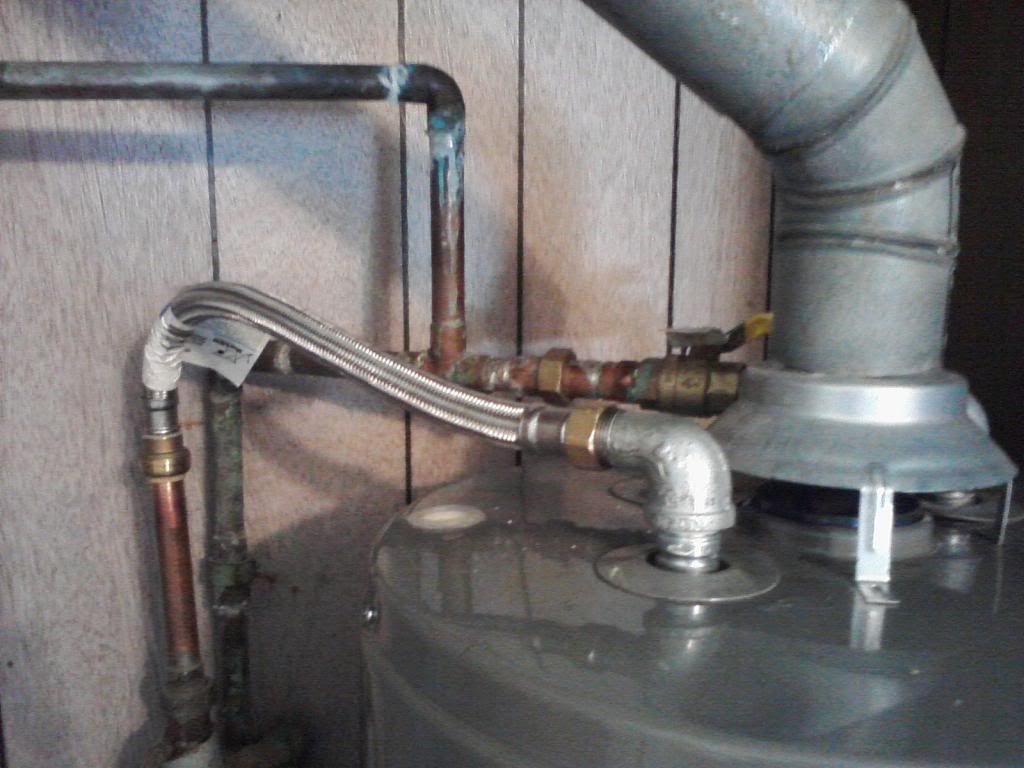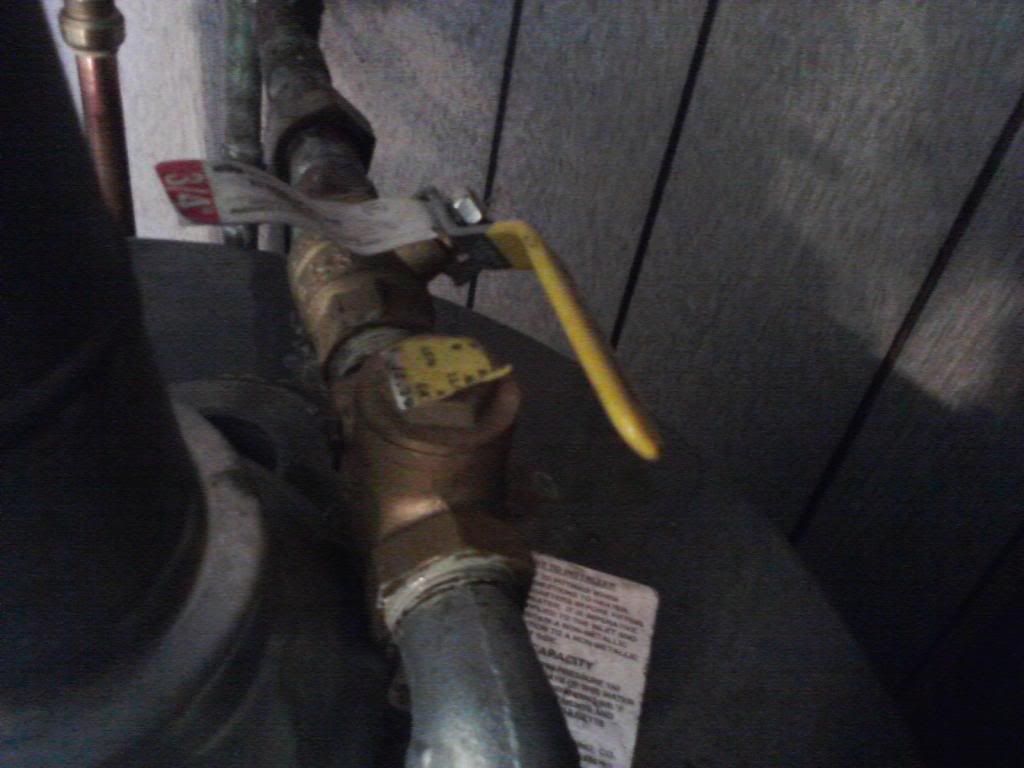
Blown pipe edition!
Hear a pop, the hot plastic line for the bathroom faucet popped out of its compression fitting. I ran for the fuse panel to kill the well (all valves are in crawlspace) but 5 gallons of water got out in the meantime.
Backstory, dad recently put in new water heater. Man at hardware store said to install check valve on inlet side to keep hot water in heater, we did. It was noted that the bathroom hot faucet was all of the sudden stiff on opening. There are no expansion tanks, hammer arrestors, etc in the system.
My theory is this check valve is either incorrect or should not be there at all, and expansion of hot water caused a pressure rise and blew the line out. ALSO, The energy card hanging of the emergency relief valve shows SIGNS OF WATER DAMAGE.
Yes? No? Sorta? I've got it reassembled now but feel like its a damn time bomb. I've left the laundry sink hot tap on slow drip for now.
More info: 1 bath home, well, 25 gallon bladder, pump kicks off at 60 psi. New heater is a propane 40 gallon Richmond.
I need more information. Is the back flow on the fresh supply side or hot side? And your T&P is easy to test, simply pull the arm to open the valve. If it will not open its bad. If it won't close all the way its bad. Also pics help
Card carrying plumber right here
All I can say is to watch the Mythbusters Episode where they explode a hot water tank. It is NOT something to mess with!
There are water connectors for your sink called "Flood Safe" that automatically shutoff should something burst. They are good protection in theory, but in my experience, they false trip a lot and require relieving the pressure on one side to reset. Kinda a pain.
The line that failed, was it a grayish plastic line? The don't have a good track record... Lucky for you it blew when you were home! Replace with threaded, braided type, house wide. I'm not saying that there isn't another problem, just that these lines suck.
I would say your check valve is the issue. But, there are lots of utilities that require check valves to prevent the back flow of contaminated house water from going back into the public supply. From the stuff I was reading if you do install a check valve you should install an expansion tank to prevent the pressure valve on the water heater from leaking or other situations like the one you had.
No particular plumbing experience, but physics tells me that the hot water in the line would be cooling , probably preventing a rise in pressure, and the max pressure would be that produced by your pump.
The check valve keeps pressure in the hot water tank and lines. When the water is heated you will have a pressure rise and the weakest link burst. Install an expansion tank on the hot water outlet of the water heater. You could also install a pressure gauge to monitor the pressure.

EvanR
HalfDork
6/19/13 11:45 a.m.
Random rant, not directed at the OP, but in general...
It's not a "hot water heater". It's a WATER HEATER. In point of fact, it is actually a "cold water heater".
Why would you heat hot water?
EvanR wrote:
Random rant, not directed at the OP, but in general...
It's not a "hot water heater". It's a WATER HEATER. In point of fact, it is actually a "cold water heater".
Why would you heat hot water?
to be more precise, it's a "heat cold water and keep it hot heater" for the majority of it's use.
I love my on demand hot water system,there is no heating water to sit in a 100 gallon tank at all.
Turn the faucet, water heats to the requested temp and flows until you turn off the faucet.
No more huge tank.
Dial up a temperature as needed.
No paying for hot water to sit in a tank.
Efficient use of resources.
Blitzed306 wrote:
I need more information. Is the back flow on the fresh supply side or hot side? And your T&P is easy to test, simply pull the arm to open the valve. If it will not open its bad. If it won't close all the way its bad. Also pics help
Card carrying plumber right here
Fresh side. I'm confident the T&P is good, its not plumbed to a drain like it should be so testing it would be messy. Its definitely shut after its evidence of opening. Reading the install manual it shows no use of a check valve, just to run the pipes down to keep convection from occurring.
Also note that I'm in the middle of nowhere, I'm not even sure of we really have code aside from state of Michigan stuff.
 Hot side is hose, the cold running up is to the softener, cold running down is cold for the whole house aside from the garden hose.
Hot side is hose, the cold running up is to the softener, cold running down is cold for the whole house aside from the garden hose.
 Yes I know, my union is on the wrong side of the shut off valve, we were in a hurry.
Yes I know, my union is on the wrong side of the shut off valve, we were in a hurry.

RossD
PowerDork
6/19/13 1:44 p.m.
t25torx wrote:
I would say your check valve is the issue. But, there are lots of utilities that require check valves to prevent the back flow of contaminated house water from going back into the public supply. From the stuff I was reading if you do install a check valve you should install an expansion tank to prevent the pressure valve on the water heater from leaking or other situations like the one you had.
The thing is that a check valve and a backflow preventer are two different things, code wise. They basically do the same thing but one needs to have yearly checks by a certified person and the other does not. It needs a check because you can have some pretty nasty stuff on the other side of that BFP and it will keep it separate from your potable water source. A check valve will not, however.
To Kenny: get rid of the check valve or get an expansion tank on the hot side. To test the T&P valve just get a bucket to test it. You should have it piped towards a floor drain or a sink for the future, though.
Your bladder tank will serve as an expansion tank once the check valve is gone. That's how mine is.

RossD
PowerDork
6/19/13 2:46 p.m.
I was going to edit my above comment, but now I'm just going with:
Remove the check valve. It shouldn't be there.
Found a government FAQ on the above issue. Backflow preventers were recently installed by the water company in my area and all residents were advised to install hot water expansion tanks. Not sure how well GA code will match up to your area but the below website may be of some benefit to you.
http://water.cobbcountyga.gov/Files/BackflowFAQ.html#FAQ5
Could anybody link me to a website that specifically states NOT to install a berkeleying check valve? Preferably also explaining that the cold water flow WONT suck hot water out of the heater, which my dad is certain will occur, burning his precious propane.













 Hot side is hose, the cold running up is to the softener, cold running down is cold for the whole house aside from the garden hose.
Hot side is hose, the cold running up is to the softener, cold running down is cold for the whole house aside from the garden hose. 
























